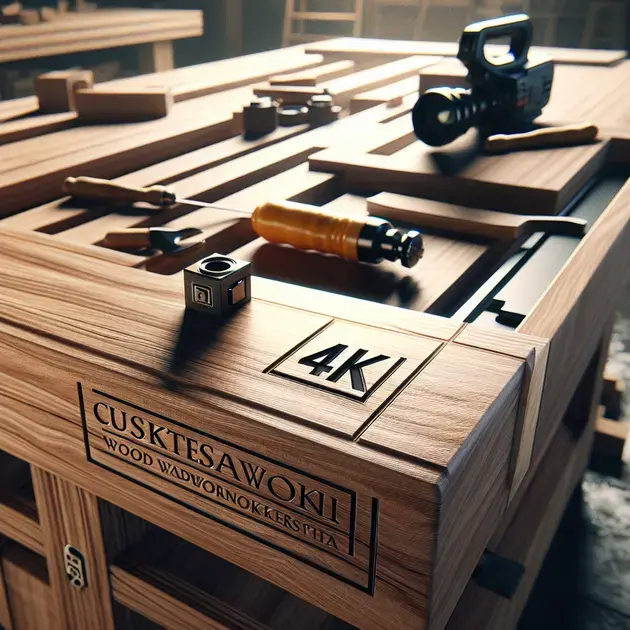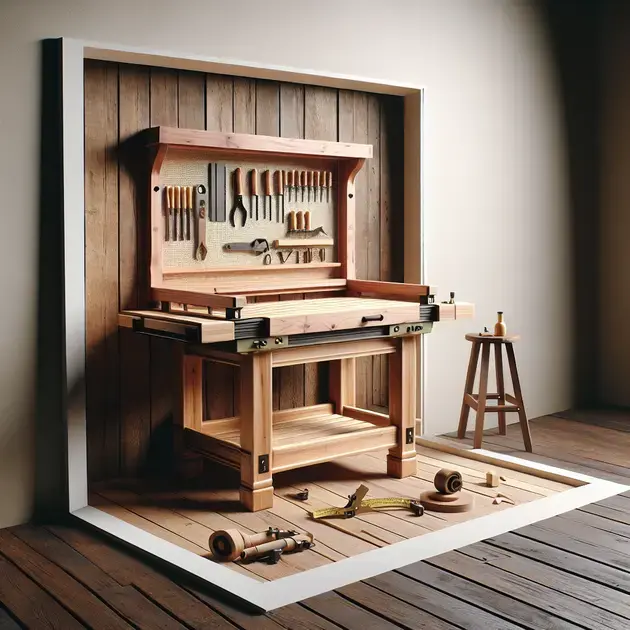Building your own woodworking bench can be a rewarding project for woodworking enthusiasts of all levels. Whether you are a beginner looking to hone your skills or an experienced craftsman wanting to customize your workspace, this guide will take you through the steps to create a quality bench that suits your needs. With detailed instructions and helpful tips, you’ll be able to craft a sturdy and functional bench that will last for years to come.
One of the key benefits of building your own woodworking bench is the ability to customize it to fit your specific requirements. From choosing the type of wood to the size and layout of the bench, you have the freedom to create a bench that is perfectly tailored to your woodworking projects. Additionally, by building your bench, you can ensure that it is built to a high standard of quality, using materials that will withstand the rigors of woodworking tasks.

Creating a Solid Foundation for Your Woodworking Bench
When building a woodworking bench, it is crucial to start with a solid foundation that will support your woodworking projects for years to come. One popular approach is to use sturdy hardwood such as oak, maple, or beech for the bench’s top. These types of wood are known for their durability and strength, making them ideal choices for a workbench.
Step 1: Planning and Preparation
Before you begin constructing your woodworking bench, take the time to carefully plan out the dimensions and design. You can use online tools such as SketchUp or AutoCAD to create a detailed blueprint of your bench. These programs allow you to visualize the final product and make any necessary adjustments before starting the build.
Step 2: Choosing the Right Materials
For the foundation of your woodworking bench, consider using thick, solid wood beams for the legs and frame. Beech or maple are excellent choices for these structural elements as they provide stability and support. Additionally, invest in high-quality hardware such as heavy-duty screws and bolts to ensure the bench is secure and long-lasting.
Step 3: Assembly and Finishing Touches
Once you have all the necessary materials and tools, it’s time to assemble your woodworking bench. Follow the blueprint carefully, ensuring that all pieces are securely attached and aligned correctly. Finally, sand down any rough edges and apply a protective finish such as polyurethane to enhance the bench’s longevity and appearance.
Step 4: Testing and Adjustments
After completing your woodworking bench, put it to the test by working on a few projects. Pay attention to any wobbling or instability and make any necessary adjustments to ensure the bench is level and sturdy. Your solid foundation will provide a reliable workspace for all your future woodworking endeavors.
Personalizing Your DIY Woodworking Bench
Adding a personal touch to your DIY woodworking bench can elevate both its appearance and functionality. Customizing your bench allows you to tailor it to your specific needs and preferences, creating a workspace that inspires creativity and productivity. Here are some tips on how to personalize your woodworking bench:
Step 1: Choosing a Design Style
Start by deciding on a design style that complements your existing workspace or workshop. Whether you prefer a rustic farmhouse look or a sleek modern aesthetic, selecting a design theme will guide the customization process and ensure a cohesive final result.
Step 2: Incorporating Storage Solutions
Consider adding storage options to your woodworking bench to keep tools and supplies organized and within reach. Install shelves, drawers, or pegboards to store small hand tools, measuring instruments, and other essentials. This not only enhances the bench’s functionality but also helps maintain a tidy workspace.
Step 3: Adding Personal Touches
Personalize your DIY woodworking bench with meaningful additions such as custom engravings, painted designs, or decals. You can also integrate elements that reflect your interests or hobbies, making the bench a reflection of your personality and style. Get creative with colors, patterns, and textures to make the bench uniquely yours.
Step 4: Implementing Ergonomic Features
Enhance the comfort and usability of your woodworking bench by incorporating ergonomic features such as adjustable height settings, padded seating, or built-in lighting. These elements not only improve efficiency and productivity but also prioritize your physical well-being during long hours of woodworking.
Ensuring Quality and Durability in Your Custom Woodworking Bench
Building a custom woodworking bench requires attention to detail and a focus on quality to ensure its longevity and performance. By selecting the right materials, following precise construction techniques, and incorporating durability-enhancing features, you can create a bench that withstands the test of time. Here’s how to ensure quality and durability in your custom woodworking bench:
Step 1: Opting for High-Quality Materials
Choose premium quality hardwoods such as walnut, cherry, or teak for your custom woodworking bench. These woods not only offer superior strength and durability but also add an elegant aesthetic to your workspace. Invest in high-grade finishing products to protect the wood from moisture, stains, and wear over time.
Step 2: Reinforcing Joints and Connections
Pay close attention to the joints and connections in your woodworking bench to prevent weak points that could compromise its stability. Use techniques such as mortise and tenon joints, dovetail joints, or dowels to create strong, secure connections that can withstand heavy use and pressure. Reinforce critical areas with metal braces or corner brackets for added durability.
Step 3: Applying Protective Coatings
Protect your custom woodworking bench from everyday wear and tear by applying durable protective coatings such as varnish, polyurethane, or epoxy resin. These coatings create a barrier against moisture, scratches, and stains, extending the lifespan of your bench and preserving its pristine appearance. Regular maintenance and reapplications will ensure ongoing durability.
Step 4: Quality Assurance Testing
Before putting your custom woodworking bench into regular use, conduct quality assurance testing to identify any weak points or structural issues. Test the bench’s stability, weight capacity, and overall performance by working on various projects and assessing its resilience. Address any concerns promptly to guarantee the quality and durability of your bench.

**Selecting the Right Materials for Your Custom Woodworking Bench**
Wood Selection
When it comes to building a custom woodworking bench, selecting the right materials is crucial for ensuring durability and functionality. One of the key factors to consider is the type of wood you’ll be using. Hardwoods such as oak, maple, and cherry are popular choices due to their strength and stability. Softwoods like pine and cedar are more affordable but may not be as durable.
To achieve a high-end look and feel, consider using exotic woods like mahogany or teak. These woods are not only beautiful but also offer excellent resistance to moisture and wear. However, keep in mind that they can be more expensive than other options.
Another important consideration is the grain pattern of the wood. Straight-grain wood is ideal for a clean and classic look, while figured grain can add visual interest to your woodworking bench. Make sure to carefully inspect the wood for any defects or knots that could affect the overall quality of your project.
Overall, the key to selecting the right wood for your custom woodworking bench is to balance aesthetics, durability, and budget. Choose a wood species that meets your needs and preferences while also considering how it will perform in the workshop.
Hardware and Accessories
In addition to the wood itself, the hardware and accessories you choose for your custom woodworking bench can also impact its overall quality and functionality. Selecting high-quality hardware such as heavy-duty vises, sturdy legs, and durable screws and bolts is essential for ensuring that your bench can withstand the rigors of woodworking projects.
Consider the type of vises and clamps you’ll need based on the specific woodworking tasks you’ll be performing. A combination of front and end vises can provide versatility for holding different types of workpieces securely in place. Don’t forget to invest in quality bench dogs, holdfasts, and other accessories that will enhance the usability of your bench.
When choosing hardware for your custom woodworking bench, opt for materials like cast iron or steel for long-lasting durability. Avoid cheap plastic or lightweight metal components that may not hold up well over time. By investing in high-quality hardware and accessories, you can ensure that your woodworking bench is a reliable and functional tool for years to come.
Remember to consider the size and weight capacity of the hardware components to ensure they are suitable for the size and scale of your woodworking projects. Choosing the right hardware and accessories is a critical step in creating a custom woodworking bench that meets your needs and enhances your woodworking experience.
Finishing Touches
Once you’ve selected the right wood and hardware for your custom woodworking bench, it’s time to add the finishing touches that will enhance its appearance and durability. Choosing the perfect finish is essential for protecting the wood from moisture, dirt, and wear, while also highlighting its natural beauty.
There are several options available for finishing your woodworking bench, including stains, paints, oils, and varnishes. Stains can add color and depth to the wood while allowing the natural grain to show through. Paints provide a durable and customizable finish, but they may obscure the wood’s natural beauty.
For a more natural look, consider using oils such as tung oil or linseed oil. These oils penetrate the wood to provide a deep, lustrous finish while enhancing its natural characteristics. Varnishes offer a glossy and protective finish that is resistant to scratches and stains, making them ideal for high-traffic workspaces.
Before applying any finish, make sure to sand the wood thoroughly to create a smooth surface. Test the finish on a small, inconspicuous area to ensure it produces the desired result. Apply the finish evenly with a brush or cloth, following the manufacturer’s instructions for drying and curing times.
**
Conclusion
**
Choosing the Right Materials
When crafting a custom woodworking bench, the choice of materials is paramount to its longevity and functionality. Opting for hardwoods like oak, maple, or cherry ensures a robust and stable bench, while softwoods such as pine and cedar offer affordability with some trade-offs in durability. For a touch of luxury, exotic woods like mahogany and teak not only beautify the bench but also resist moisture and wear exceptionally well. To strike a balance, consider the wood type’s aesthetics, durability, and your budget to find the perfect fit.
Essential Hardware Selection
Alongside the wood, selecting high-quality hardware and accessories is pivotal to the overall quality and utility of your woodworking bench. Heavy-duty vises, sturdy legs, and durable screws and bolts are indispensable for enduring woodworking projects’ demands. Tailor your choice of vises and clamps to the tasks at hand, with a mix of front and end vises for versatile workpiece securing. Invest in top-notch bench dogs, holdfasts, and durable materials like cast iron or steel, steering clear of flimsy components for lasting performance that enhances your woodworking experience.
Perfecting the Finish
After solidifying your wood and hardware choices, it’s time to elevate your woodworking bench with the right finish. Opt for stains to enrich the wood’s color and texture, paints for durability and customization, or oils like tung or linseed for a natural, lustrous finish that accentuates the wood’s features. Varnishes provide a glossy, protective sheen ideal for busy workspaces, shielding the bench from scratches and stains. Ensure a smooth surface by thorough sanding before applying the finish evenly, following the manufacturer’s instructions for a flawless outcome.